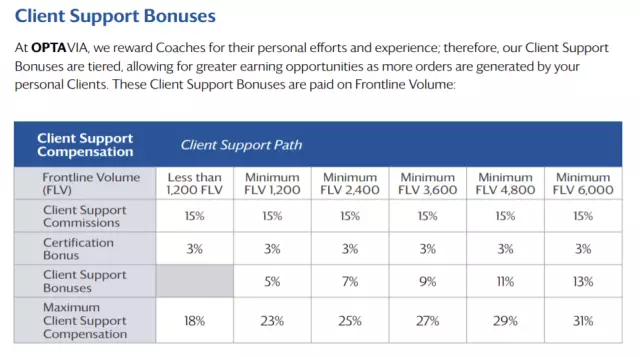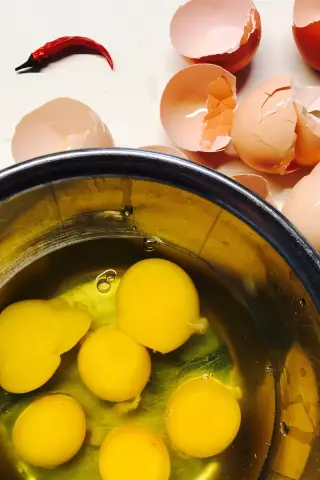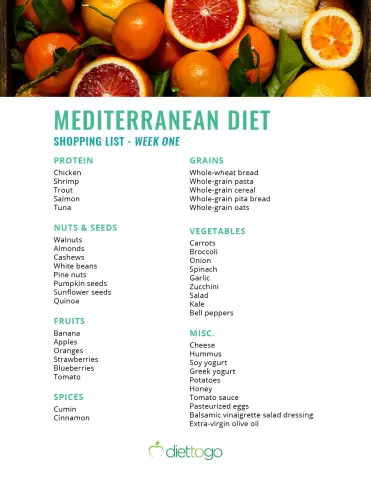- Author Rachel Wainwright [email protected].
- Public 2024-01-15 19:51.
- Last modified 2025-11-02 20:14.
Dr. Hay's diet
American physician William Hay is one of the founders of separate nutrition, which is so popular today. Dr. Hay developed his diet at the beginning of the 20th century, when he himself suffered from obesity and severe kidney disease. As a result, he managed to improve his health and lose 23 kg. Later, he described his discovery in several books, gaining many followers all over the world.
The essence of the system: the products are divided into starchy, proteinaceous and neutral:
- Starchy: bread, pasta and other flour products, cereals (except buckwheat), potatoes, sugar and sweets, honey, tea.
- Protein: meat, fish, poultry, offal, eggs, legumes, mushrooms, nuts, sunflower seeds.
- Neutral: dairy and fermented milk products, fresh fruits and vegetables (except potatoes), berries, dried fruits, buckwheat, vegetable oil and animal fat.
Starchy and protein foods should be eaten separately, and neutral foods can be combined with both in one meal.
Dr. Hay's Diet Rules:
- carbohydrates should not be combined with proteins and sour fruits;
- the share of foods that increase the acidity of the blood (vegetables, milk, fruits, except citrus fruits) should be four times more than the share of foods that increase the acidity of gastric juice (carbohydrates, proteins, nuts and citrus fruits), that is, the basis of food is a neutral group of products, mainly fresh fruits and vegetables;
- three meals a day are provided with intervals of four to five hours between them;
- breakfast - products from the neutral group, lunch - protein products in combination with vegetables and fruits, dinner - starchy foods with vegetables and fruits.
The diet is followed as long as it takes to normalize weight, the minimum period for obtaining an effect is two weeks. After reaching the optimal weight, you can gradually expand the diet, maintaining the principle of separate consumption of products, and adhere to such a nutrition system as long as you like.

Source: depositphotos.com
Advantages of Dr. Hay's Diet
Dr. Hay's diet allows you to get rid of 1.5-2 kg per week without risk to health, while at first the plumb line is faster, and as the weight normalizes, it slows down. This pace may seem slow, but in fact it is optimal from a physiological point of view.
William Hay's system is balanced in the main types of food, does not exclude any of their groups, and therefore provides the needs of the body and is easily tolerated.
The diet includes a large amount of vegetables and fruits, so the body is saturated with vitamins and minerals, and the fiber contained in plant products improves bowel function.
Disadvantages and contraindications of Dr. Hay's diet
Dr. Hay's diet can be built taking into account the individual characteristics of the body, therefore it has practically no contraindications, with the exception of diseases of the digestive system - in this case, a large amount of raw plant foods is not recommended.
What foods are allowed?
- Protein: meat, poultry, fish, offal, eggs, nuts, legumes.
- Starchy: bread and other baked goods made from wholemeal flour, pasta made from durum wheat, cereals (except semolina), potatoes.
- Neutral: unrefined vegetable oils, butter, cheese with a fat content not exceeding 45%, milk, sour cream, cottage cheese, cream, natural yogurt, fresh vegetables (except potatoes), mushrooms, herbs, fruits, dried fruits, berries, honey, tea, sunflower seeds.
What foods are prohibited?
- Sugar.
- Salt.
- Confectionery.
- White flour products.
- Sausages, sausages.
- Canned food, sauces, food additives.
- Margarine.
- Low fat yogurt.
- Carbonated drinks.
Dr. Hay's diet menu
Sample menu of Dr. Hay's diet for 14 days:
Breakfast: yoghurt with fresh strawberries.
Lunch: pork baked with parsnips, broccoli and carrots, any soft fruit (peach, apricot).
Dinner: jacket potatoes, bell peppers and corn, banana with honey and whipped cream.
Breakfast: dates, banana, a slice of bread with peanut butter.
Lunch: salad of fresh vegetables, grilled chicken fillet, pear.
Dinner: vegetable salad of cabbage, rutabagas and carrots, orange and pineapple.
Breakfast: yoghurt with peaches and nuts.
Lunch: salad of peas, cabbage and carrots, cod baked with cheese, apple, peach.
Dinner: lettuce, stewed vegetables or vegetable pie, grapes.
Breakfast: a piece of melon.
Lunch: chicken baked with broccoli, parsnips and carrots, kiwi, orange.
Dinner: peanut butter rye bread, tomato and avocado salad, banana.
Breakfast: yoghurt with nectarine.
Lunch: beets with onions and watercress, omelet with mushrooms and cheese, carrots, peas, tomatoes, orange.
Dinner: green salad, jacket potatoes with avocado, bell pepper, onions, corn.
Breakfast: crushed wheat with soy milk, raisins.
Lunch: chicken baked with mushrooms, salad of beans, cabbage and carrots, mango.
Dinner: salad of fresh and dried fruits with sunflower seeds and hazelnuts.
Breakfast: grapefruit and orange, raisins, nuts.
Lunch: chopped lamb with broccoli, peas and carrots, raspberries with cream.
Dinner: pita with salad, vegetable soup, pear.
Breakfast: toast, banana puree.
Lunch: cauliflower casserole with cheese, poached egg, sweet corn, carrots, tomato, orange, raisins.
Dinner: cucumber and tomato with watercress, jacket potatoes, bell peppers, sweet corn.
Breakfast: muesli with banana and soy milk.
Lunch: vegetable salad, roast turkey, kiwi and orange salad.
Dinner: vegetable salad, vegetable soup, dates.
Breakfast: yogurt with apple and almonds.
Lunch: Brussels sprouts, carrots, beef baked with tomatoes and mushrooms, fruit juice and pineapple jelly.
Dinner: corn on the cob with carrot, onion, beet and lettuce salad, sweet fruit.
Breakfast: cottage cheese with sour cream, banana.
Lunch: salad of corn, sweet peppers and carrots, scrambled eggs with cheese, pear.
Dinner: vegetable salad, brown rice, dates.
Breakfast: bananas with chopped nuts and whipped cream.
Lunch: cauliflower, peas, carrot salad, baked cod, orange.
Dinner: jacket potatoes, vegetables baked with sesame seeds, pear.
Breakfast: porridge, raisins.
Lunch: carrots, broccoli, lamb chop with tomatoes and mushrooms, orange and pineapple salad.
Dinner: green salad, lentil soup, a slice of bread, avocado.
Breakfast: blueberries, apple, yogurt.
Lunch: green salad, cucumbers, tomatoes, steak with mushrooms, kiwi with baked apple and cream.
Dinner: banana sandwich, raisins, grapes.
Useful Tips
Advice 1. It is advisable not to forget about the drinking regime - you should drink at least 1 liter of water per day.
Tip 2. Regular moderate physical activity makes the diet more effective and contributes to the overall health of the body.
| Diet characteristic | final grade |
| Duration: from 2 weeks |
3.5 out of 5 One of the first, and maybe the first separate power supply system. It was offered to the general public by Dr. William Hay of New York. You can practice this diet for as long as you like. |
| Recommended frequency: any | |
| Weight loss rate: | |
| Safety: | |
| Variety of products: |
YouTube video related to the article:
Found a mistake in the text? Select it and press Ctrl + Enter.






